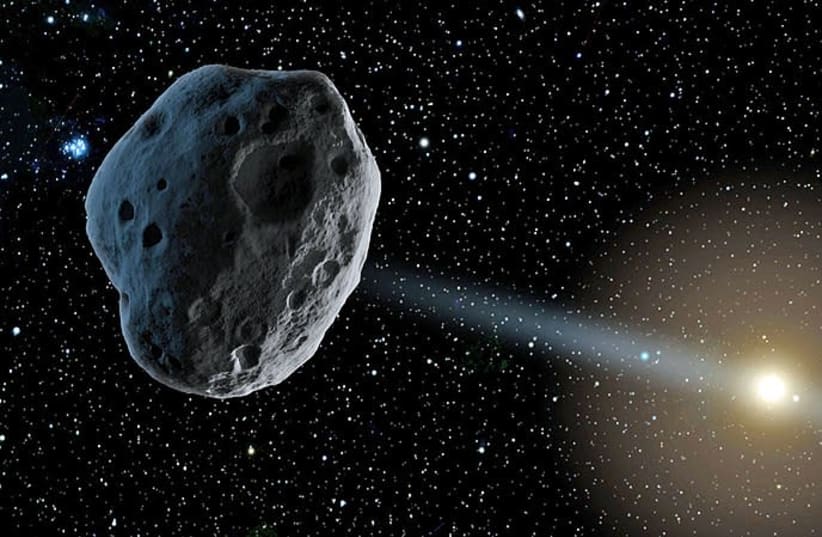But the satellites capable of making these very broadcasts may just be the things that can save the planet.
TV broadcast satellites, according to a study by European company Airbus Space, can easily and quickly be, essentially, hijacked and repurposed into a means of deflecting an incoming asteroid.
Despite the seemingly far-off nature of a possible asteroid collision, the scenario is far from unlikely. Astronomers around the world, including NASA's Planetary Defense Coordination Office (PDCO), work to monitor all nearby asteroids and calculate their trajectory to see if any of them pose a threat to the planet.
And asteroids have struck the planet before. The most famous incident in recent memory was the 1908 Tunguska event, when an asteroid exploded above the Earth's surface in part of Russia. Though not directly impacting the planet itself, the force of the asteroid was still devastating, being one of the largest explosions in history, flattening around 80 million trees in an area over 2,100 square miles in size.
And while it was the most devastating, it was not the most recent. In 2013, again in Russia, another asteroid exploded 14 miles above the Earth's surface. The asteroid was about the size of a house, traveled over 11 miles per second and exploded with the force of approximately 440,000 tons of TNT. The shock wave broke windows in a range of 200 square miles, damaged buildings and injured around 1,600 people. The fact that this happened has made it even more important for experts to find solutions to stop asteroids.
While the most popular solution presented in science fiction is the use of nukes, this is far from ideal, as it would still cause an explosion of rocks to rain down on Earth and cause significant destruction.
One proposed solution put forward by NASA's PDCO and John Hopkins University is the Double Asteroid Redirection Test (DART) Mission, which proposed sending a rocket at an asteroid to utilize speed and its impact to alter an asteroid's trajectory ever so slightly, enough to throw it off course.
Or, in layman's terms, punching it with a rocket with enough speed to change its direction by a fraction of a percent.
One of the lead scientists on it, Andy Rivkin, even wrote a song about it.
The DART Mission is set to be tested in the fall, with the specialized spacecraft to be launched and directed at an asteroid far away in the Didymos asteroid system – which doesn't pose any threat to Earth. It is expected to arrive and finish its mission by September 2022.
Another similar initiative has been considered by China's National Space Science Center, where researchers found in simulations that 23 Long March 5 rockets hitting simultaneously could deflect a large asteroid from its original path by a distance 1.4 times the Earth's radius.
But both of these initiatives come with a fatal problem: They take time to set up. And in a crisis, a faster, more ad hoc solution might be needed.
In total, the European Space Agency (ESA) deduced that a time frame of just six months would be needed to launch such a mission to stop an asteroid.
And that is exactly what Airbus is proposing in its Fast Kinetic Deflection (FastKD) study.
A satellite would need to be hijacked, or rather, repurposed, for this job. This would take modifications, but such satellites are regularly being built or are under construction, so they are frequently available. These satellites are large enough on their own, and the scientists would only need to add two things: A special kinetic deflection (KD) module and a smaller "piggyback" satellite.
The module in question would have a separate means of propulsion and a dedicated navigation system to help keep the approach to the asteroid precise. The mini-satellite would have a camera in order to observe and confirm the mission's success.
Just as the case with DART, this is not trying to destroy an asteroid, but redirect it.
"If you calculate the overall scenario," Albert Falke, who led the Fast Kinetic Deflection (FastKD) study at Airbus, explained in a statement on the Airbus website, "with an asteroid still three years away from possible impact, we have a whole six months to react and launch the mission - including political decision-making." After the launch, there is a six to eighteen-month flight phase to reach the asteroid at a great distance from Earth, ram it and thus deflect it.
"The 'hijacking' scenario would deliver the fastest possible launch readiness, but at the same time requires a great deal of preparation," Falke continued, meaning a tested module would always need to be on standby.
The idea of using communications satellites for deflection is interesting, however, according to Rivkin, who was not involved in the Airbus study, it does have its drawbacks.Most notably, the issue he pointed out was location."Hazardous asteroids come from all directions, and it's not necessarily the case that it'd be cheaper or easier to get a satellite from geosynchronous orbit into position to intercept an asteroid compared to launching from the Earth," he told The Jerusalem Post.And indeed, this has been shown by NASA. Despite NASA announcing Earth was free of any risk of asteroid impacts for the next 100 years, more asteroids are discovered every day, and many more still approach Earth. On July 12 alone, two asteroids the size of airplanes are set to fly relatively close by the planet.
So while the risk may not be immediate, it never hurts to be prepared.
Reuters contributed to this report.
